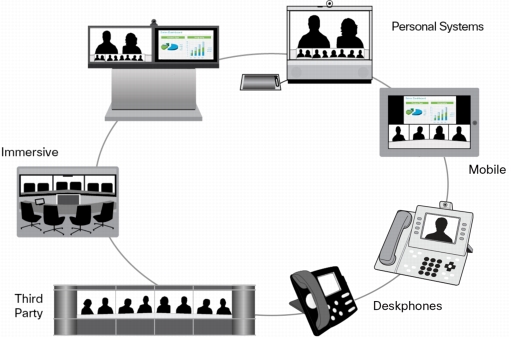
Cisco TelePresence Server
Flexible, Scalable TelePresence Conferencing

Our Price: Request a Quote
Click here for more options and pricing!
Please Note: All Prices are Inclusive of GST
Overview:
The Cisco TelePresence Server is an innovative software solution enabling high-quality standards-based conferencing for the mobile or desktop user and the immersive room meeting participant. Compatible with a range of hardware platforms, the Cisco TelePresence Server is a versatile, highly scalable solution for mid market and larger enterprise customers.
The Cisco TelePresence Server is a key component of the Cisco Pervasive Conferencing architecture, and is deployed with Cisco TelePresence Conductor in order to provide full flexibility and scale.
WebEx enabled TelePresence, with the Cisco TelePresence Server, allows you to enjoy fully integrated, scalable conferences involving WebEx users and telepresence endpoints.
The Cisco TelePresence Server provides high-quality, flexible, 360p to full high-definition (FullHD) multiparty conferencing and collaboration. Specifically engineered to deliver the best user experience for any device, the Cisco TelePresence Server provides predictable, reliable, high-quality video and content-sharing capabilities.
With views optimized for meeting rooms and desktop and mobile devices using Cisco Jabber™ the Cisco TelePresence Server delivers any-to-any multiparty conferencing. To enhance the experience, conference attendees can gain the full benefit of screen layouts designed specifically to meet their needs.
The Cisco ActivePresence capability of Cisco TelePresence Server, a leading patent-pending feature, enables the delivery of next-generation multiparty conferencing, offering a view of all attendees in a meeting while giving prominence to the active speaker. While the active speaker occupies most of the screen, an overlay of others in the call appears in the lower third of the screen, giving participants a natural view of everyone sitting around the virtual table.

Figure 1. Examples of Cisco TelePresence Server Supported Modes
A critical requirement for all customers is ensuring a high return on investment (ROI). The Cisco TelePresence Server has a software upgrade path that enables customers to deploy new features as required, and with a cost-effective licensing model, they can closely manage their investment while reaping the rewards of lower travel expenses and increased employee productivity.
Designed to meet the needs of organizations from small businesses to global multinationals, the Cisco TelePresence Server has a scalable architecture, enabling customers to start small and increase the scale of their solutions as their businesses grow.
It is compatible with a range of hardware platforms, enabling you to select the solution most suited to your needs:
- The Cisco TelePresence Server on virtual machine, which runs on the Cisco Unified Computing System™ (Cisco UCS) or third party specification-based server platforms, offers a virtualized solution.
- The Cisco TelePresence Server on the Cisco Multiparty Media 310 and Cisco Multiparty Media 320 entry level appliance solutions which can be stacked to grow with your business video usage over the long term.
- The Cisco TelePresence Server on the Cisco TelePresence Server MSE 8710 (Cisco MSE 8710) is a chassis-based platform that is ideal for large enterprises and service providers requiring a high-availability and highly scalable solution. Scalability is achieved through clustering up to four Cisco MSE 8710 blades as a single unit.
- The Cisco TelePresence Server can also run on the Cisco MSE 8510 and Cisco TelePresence MCU 5300 (MCU 5300) platforms.
Flexible, Scalable TelePresence Conferencing
The Cisco TelePresence Server provides high-quality, standards-based conferencing for the mobile or desktop user and the immersive room meeting participant. It is a key component of the Cisco Pervasive Conferencing architecture and compatible with a range of hardware platforms. The Cisco TelePresence Server is a versatile, highly scalable solution for mid-market and larger enterprise customers.
- Provides 360p to full high-definition (FullHD) multiparty conferencing and collaboration
- Makes it easy to join meetings from WebEx Meeting Center clients or telepresence systems
- Flexible platform deployment options: chassis or appliance options, with new entry level appliance and virtualized options now available
- Is compatible with standards-based, third-party vendors' endpoints for multipoint calls
- Supports Cisco ActivePresence and Cisco ClearPath to enhance the user experience
The Cisco TelePresence Server on Virtual Machine runs on the Cisco Unified Computing System (Cisco UCS) or third party specification-based server platforms.
The Cisco TelePresence Server on the Cisco Multiparty Media 310 and Cisco Multiparty Media 320 offers entry level appliance options.
The Cisco TelePresence Server on the Cisco TelePresence Server MSE 8710 is a chassis-based platform ideal for large enterprises and service providers requiring a high-availability and highly scalable solution.
The Cisco TelePresence Server can also run on the Cisco TelePresence MCU MSE 8510 platform.
Features and Benefits:
Benefits of Cisco TelePresence Server
- WebEx enabled telepresence allows you to join a conference from WebEx or telepresence endpoints - highly scalable conferencing from any location using any device.
- Cisco TelePresence Server works in conjunction with Cisco TelePresence Conductor (v2.2 or later) or CTX (v1.3 or later), providing scalable ad-hoc conferencing and enabling increased efficiency.
- Dynamic optimization: Make full use of the conferencing capacity of Cisco TelePresence Server through the dynamic allocation of resources.
- Conference service levels range from 360p video with composited content through to FullHD video with FullHD content.
- Mixed conference types (ad hoc and rendezvous) and mixed resolutions (360p to FullHD) are supported. - Improved productivity: All users enjoy a high-quality experience, accessible from mobile devices running Jabber through to desktop or immersive systems. Thus remote and home workers can collaborate more effectively and decrease travel costs.
- Best in class experience for the user device: Highly scalable conferencing is available to users with mobile, meeting room or immersive endpoints.
- Maximized reach: Optimized views and standards-based interoperability allow any-to-any conferencing, helping ensure conferences are effective and support a wide range of participant endpoints.
| Feature Summary | |
|---|---|
| Design features |
|
| Application features |
|
| Performance features |
|
Figure 1 shows a graphic of the Cisco TelePresence Server interoperability solution.

Figure 1. Cisco TelePresence Server Interoperability
Platform Scale:
| Platform | Scale Parameters |
|---|---|
| Cisco TelePresence Server MSE 8710 |
|
| Cisco Multiparty Media 310 |
|
| Cisco Multiparty Media 320 |
|
| Cisco TelePresence Server 7010 |
|
| Cisco UCS platform |
|
Note: Capacity figures represent capabilities of Cisco TelePresence Server 3.1 when used with Cisco TelePresence Conductor 2.2.
Technical Specifications:
Tables list the technical, video, network, and audio, and network, management and security specifications, respectively, of Cisco TelePresence Server.
| Technical Specifications | |
|---|---|
| Product compatibility | The server is standards-based and compatible with major vendors' endpoints. |
| Universal transcoding and transrating |
|
| Content features |
|
| Built-in web server | Complete configuration, control, and monitoring of the system and conferences are supported. |
| Language support | English is the standard language. |
| Network, Security and Management Specifications | |
| Bandwidth | Up to 6 Mbps with both H.263 and H.264, for each screen in all conference modes |
| Video standards |
|
| Video resolution |
|
| Frame rates | Up to 60 fps |
| Audio standards |
|
| Audio features |
|
| Network, Management and Security Specifications | |
| Protocols |
|
| Security features |
|
| System management |
|
| Quality of service (QoS) | The server provides configurable differentiated services code point (DSCP) or type of service (ToS)/IP Precedence. |
| Network resilience |
|
| Physical Specifications - Cisco TelePresence MSE 8710 | |
| Physical dimensions | (H x W x D): 33.25 x 17.2 x 20.5 in. (842 x 437 x 520 mm) (19 rack units [19RUs]) 19-inch rack-mountable (kit supplied) |
| Weight | 14.6 lb (6.6 kg) |
| Power |
|
| Environmental data |
|
| Approvals and compliance |
|
| Physical Specifications - Cisco Multiparty Media 310 and Cisco Multiparty Media 320 | |
| Physical dimensions | (H x W x D): 1.75 x 17.4 x 16.7 in. (44.5 x 442 x 423 mm) (1RU) 19-in. rack-mountable (kit supplied) or standalone |
| Weight | 17.6 lb (8 kg) |
| Power |
|
| Environmental data |
|
| Approvals and compliance |
|
| Physical Specifications - Cisco TelePresence TS 7010 | |
| Chassis physical dimensions (H x W x D) | (H x W x D): 3.43 x 17.25 x 19.1 in. (87 x 436 x 511 mm) (2RU) 19-in. rack-mountable (kit supplied) or standalone |
| Weight | 33 lb (15kg) |
| Power | 100-240 VAC, 50/60 Hz; maximum power consumption 650W |
| Environmental data |
|
| Approvals and compliance |
|
1 Cisco TelePresence Server on the Media 310, Media 320, and Virtual Editions only support remotely managed mode, which requires an additional external application such as the Cisco TelePresence Conductor (v2.0 or later) or the CTX (v1.3 or later).
* Cisco TelePresence Server software (R-VTS-K9) requires UCS or standard based server based platforms, for information on tested/recommended hardware, please see Cisco Virtualization http://www.cisco.com/en/US/docs/telepresence/infrastructure/ts/install_guide/vts_install.pdf.
Documentation:
Download the Cisco TelePresence Server Datasheet (PDF).
Pricing Notes:
- All Prices are Inclusive of GST
- Pricing and product availability subject to change without notice.
Our Price: Request a Quote
Our Price: Request a Quote
Our Price: Request a Quote
Our Price: Request a Quote

